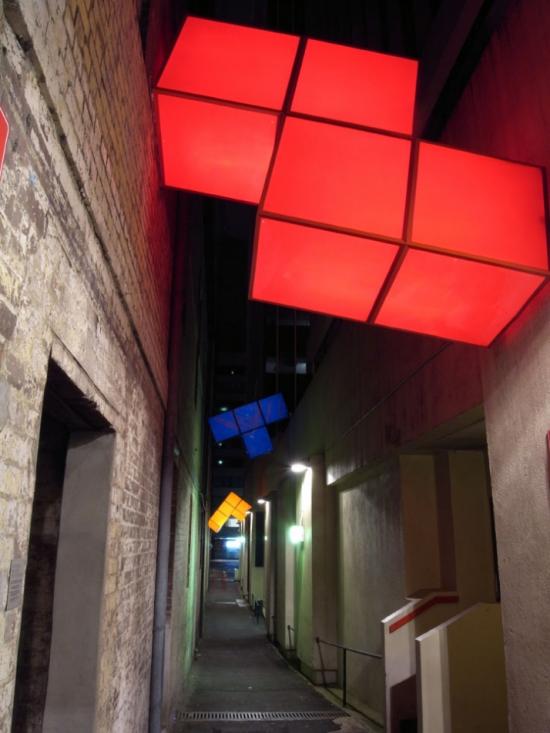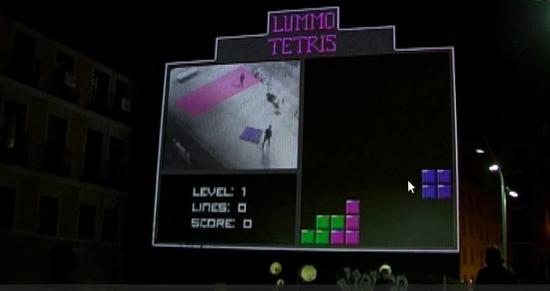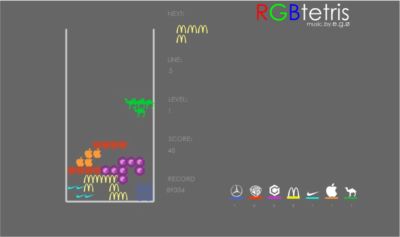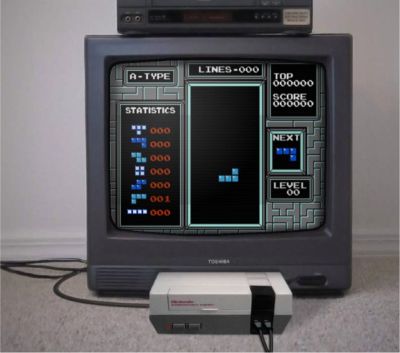



In the second part of classic videogames that have inspired contemporary artists, we take a closer look at a game that the Cubists probably would have worshiped. Tetris was created in 1984 and then released officially in 1985 by the Russian programmer Alexey Pajitnov. In Tetris you have to move and rotate seven different combinations of blocks as they fall into a well. The blocks are called tetrominos and are made of four squares. The goal is to fit the different geometric shapes so that as little empty space as possible remains in the bottom of the well. Tetris is a puzzle game for people who like compact living, and who see it as a sport to pack economically to the holiday.
In contemporary art you can find three main approaches how artists have used Tetris. The Swedish artist Michael Johansson is a good example of the first approach. He has used the basic idea of Tetris to stack objects with different colors and shape. Johansson works with site-specific installations, in which he collects and stacks objects from the near surroundings in perfect symmetry with no spaces. The installations are called Tetris, which is fitting since they are strongly reminiscent of the game.

“For me creating works by stacking and organizing ordinary objects is very much about putting things we all recognize from a certain situation into a new context, and by this altering their meaning. And I think for me the most fascinating thing with the Tetris-effect is the fusion of two different worlds, that something you recognize from the world of the videogame merges into the real life as well, and makes you step out from your daily routine and look at things in a different way.” says Johansson in an interview at Gamescenes.org
Like many other classical videogames, Tetris has been used a lot in public spaces as in graffiti, mosaics and posters on facades and in subways etc. In Sydney, Australia, artists Ella Barclay, Adrianne Tasker, Ben Backhouse and Kelly Robson in 2008 at an exhibition at Gaffa Gallery created an installation where they placed giant illuminated Tetris Blocks in a narrow alley. It looked exactly as if the blocks had fallen from the sky, but the alley had been too narrow so the blocks were stuck halfway down.

The second approach is to move Tetris out from the exhibition room into public spaces and sometimes also create interactive and social art. The artist group Blinkenlights, who are known for transforming large skyscrapers into interactive screens, on various occasions making it possible for the passing public by to play Pong or Tetris on a skyscraper using a mobile phone. In 2002 they made the installation Arcade, which turned one of the skyscrapers in the Bibliotheque Nationale de France in Paris to a giant screen showing various animations, where a passersby could also play arcade games like Tetris.
The artist group Lummo (Carles Gutierrez, Javier Lloret, Mar Canet & JordiPuig) created in Madrid in early 2010, a Tetris game in which four people have to cooperate to play it. The first step for the participations was to create the Tetris blocks and after that they had to work together to place on right position in the well which was projected on a wall. In Both cases, Blinkenlights and Lummo are creating public meeting places with social interaction where the videogame is used as an interface.

The third approach is changing the game itself and creates new versions of the game which discuss the game idea. The artist group version [url=http://www.tetris1d.org/]1d Tetris[/url], is a one-dimensional Tetris where the blocks consist of four vertical squares falling into a well that is just one block wide. Since the blocks always fill the well the players do not have to do anything to score points. The basic idea of the falling blocks still remains in the game, but in a one-dimensional world there is no longer any difficulty, the game is reduced to a very monotonous and predictable puzzle game.

In First Person Tetris the artist David Kraftsow combines the perspective from the popular first person shooter genre (used in war and action games) with the ordinary puzzle game. In Kraftsows variant you see the game from a first person perspective so when you spin the blocks, it is not the individual blocks that are spinning around but instead the whole screen. Just by using a new perspective in the game has Kraftsow created a whole new experience of Tetris. Mauro Ceolin, who has spent many years focusing on the modern emblems on the Internet. In works such as RGBTetris and RGBInvaders he replaces the game’s graphics with contemporary icons and logos. In RGBTetris the blocks that fall down the well are exchanged with logos from Camel, McDonalds, Nike and Mercedes.

The most interesting and most independent among the playable Tetris versions that I have found are made by the Swedish artist Ida Roden. In Composition Grid she has combined her interest in drawing with Tetris. The player can play a game and in the same time create a unique drawing by rotating and changing one of the 216 different creatures that Roden has created, with the Tetris blocks as model. The player can then choose to print out their own game plan with the artist’s signature, and in that way have a unique work of art in there possession.
Tetris, this two-dimensional version of Rubik’s Cube, seems to create a lot of room for artistic experimentation. It just needs some simple changes, or new perspectives, to create a new and interesting interpretations of the game.
Videogame appropriation in contemporary art: Pong. Part 1 by Mathias Jansson.
Some of these new Tetris games can be found at these addresses:
www.rgbproject.com/RGBtetris/RGBtetris.swf
www.tetris1d.org
www.firstpersontetris.com
www.idaroden.com/composition.html